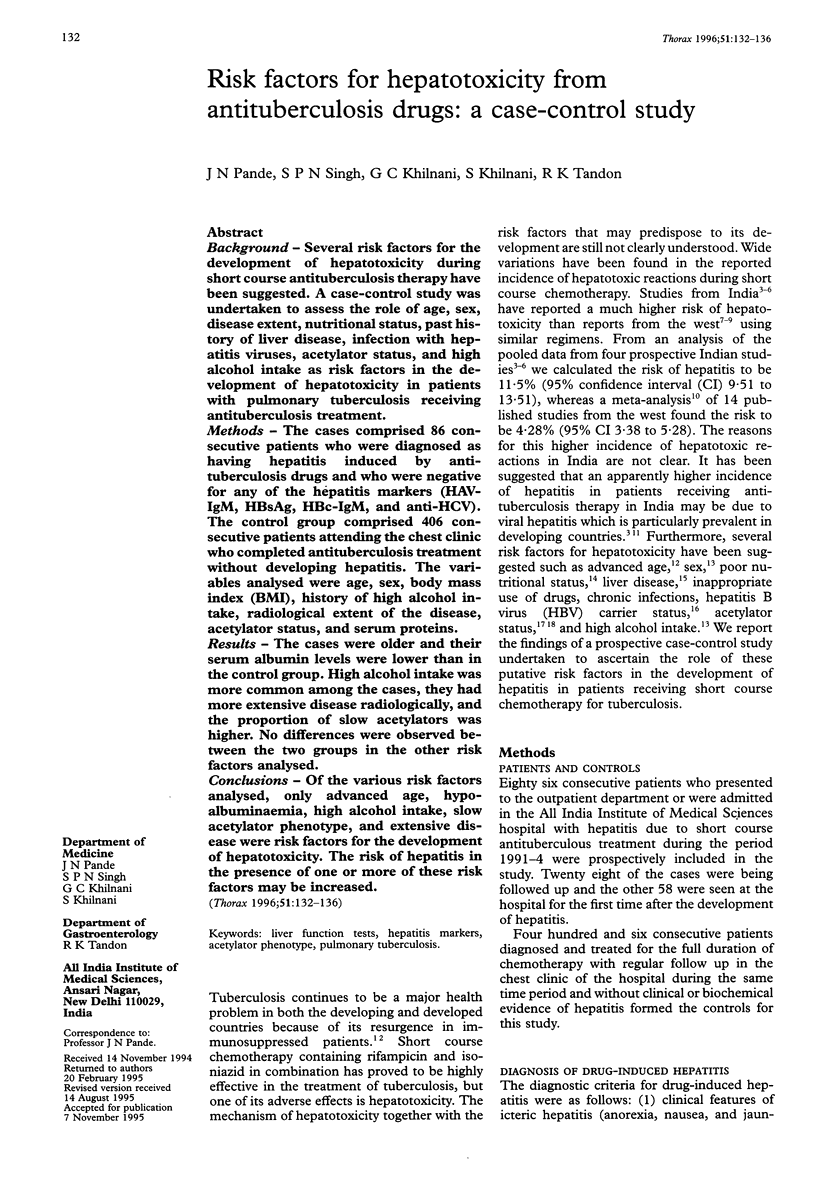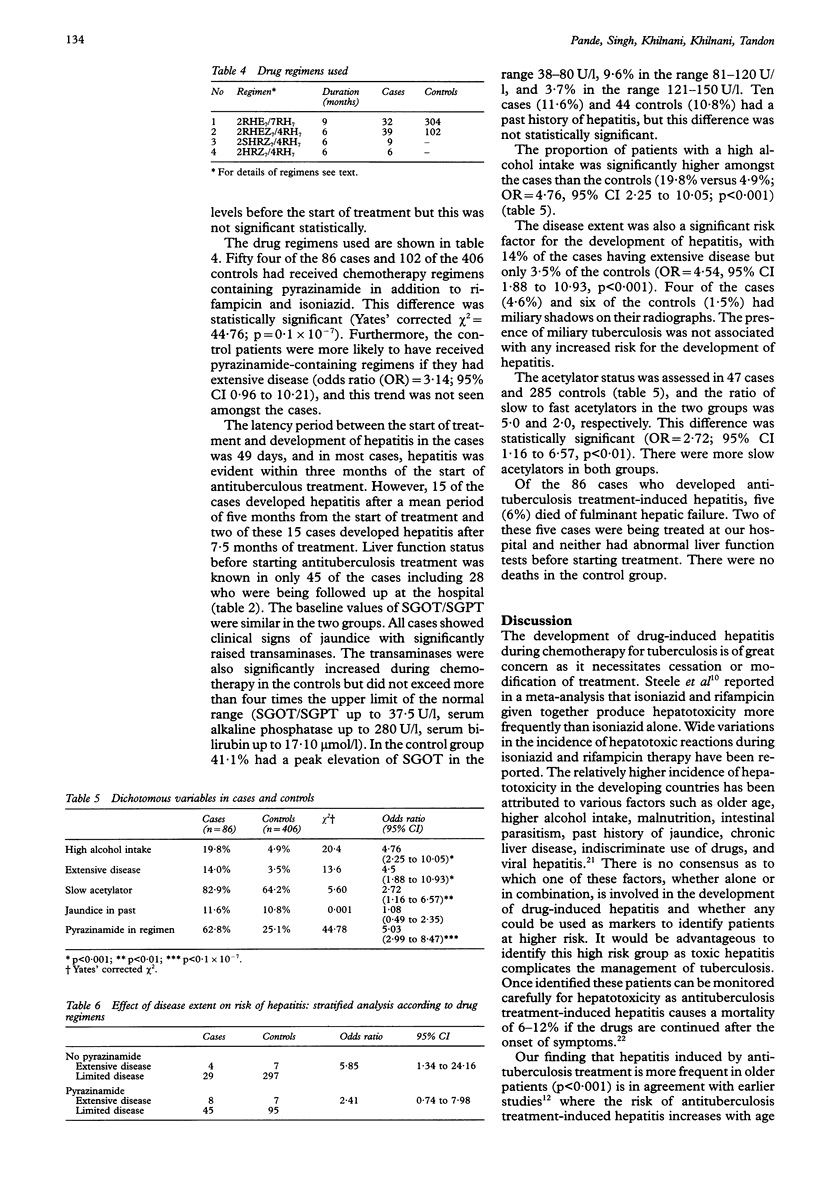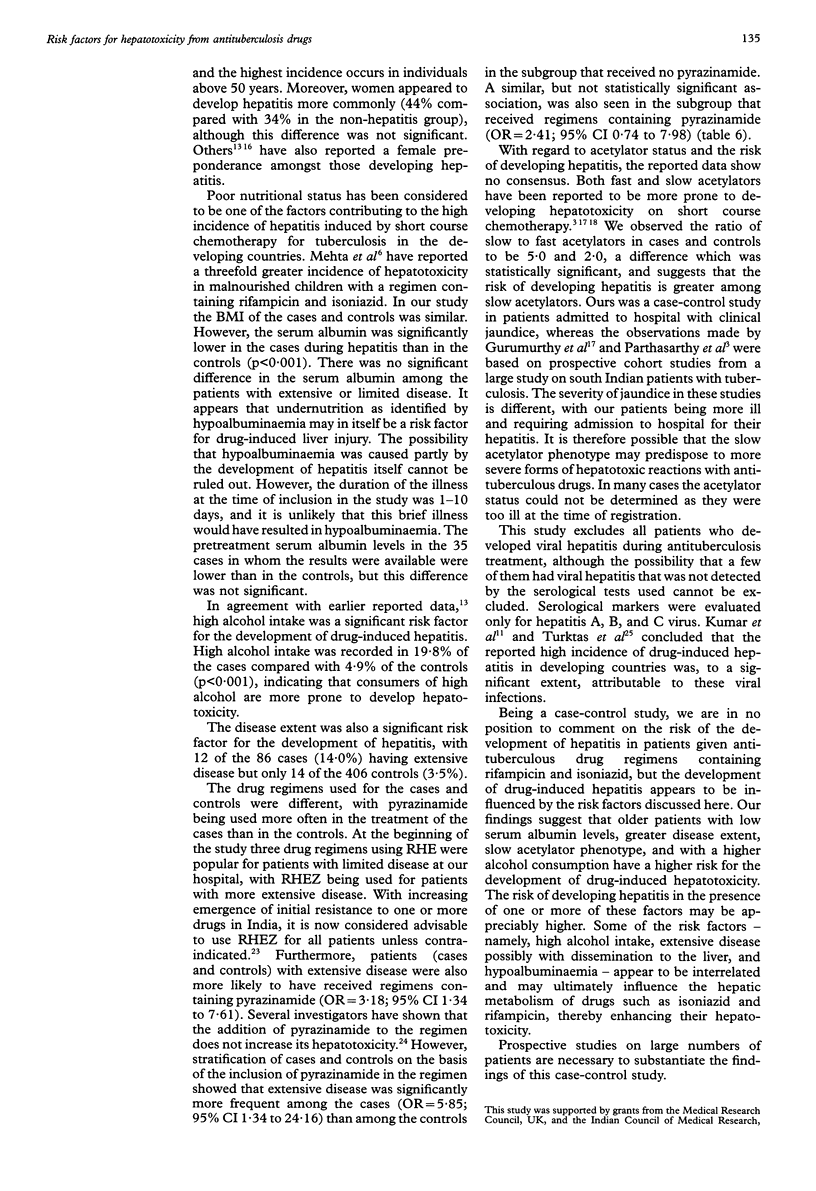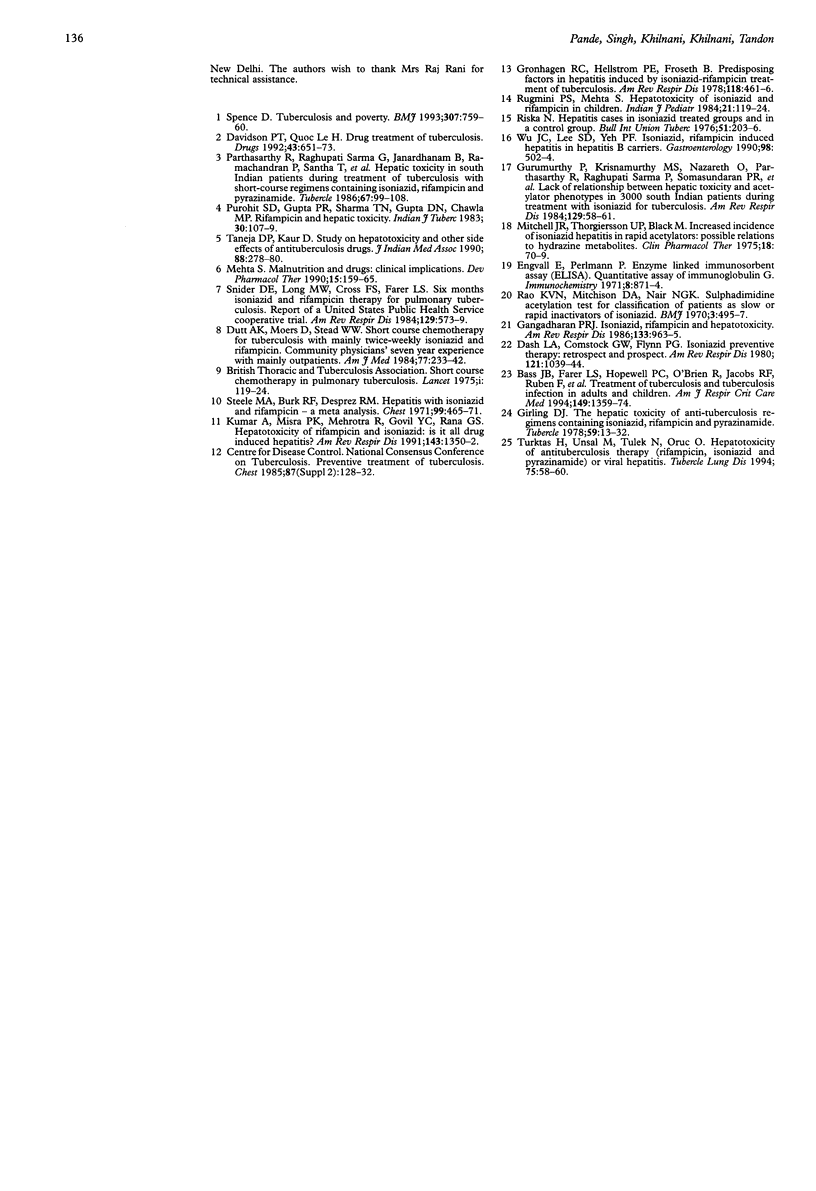Abstract
BACKGROUND: Several risk factors for the development of hepatotoxicity during short course antituberculosis therapy have been suggested. A case-control study was undertaken to assess the role of age, sex, disease extent, nutritional status, past history of liver disease, infection with hepatitis viruses, acetylator status, and high alcohol intake as risk factors in the development of hepatotoxicity in patients with pulmonary tuberculosis receiving antituberculosis treatment. METHODS: The cases comprised 86 consecutive patients who were diagnosed as having hepatitis induced by antituberculosis drugs and who were negative for any of the hepatitis markers (HAV-IgM, HBsAg, HBc-IgM, and anti-HCV). The control group comprised 406 consecutive patients attending the chest clinic who completed antituberculosis treatment without developing hepatitis. The variables analysed were age, sex, body mass index (BMI), history of high alcohol intake, radiological extent of the disease, acetylator status, and serum proteins. RESULTS: The cases were older and their serum albumin levels were lower than in the control group. High alcohol intake was more common among the cases, they had more extensive disease radiologically, and the proportion of slow acetylators was higher. No differences were observed between the two groups in the other risk factors analysed. CONCLUSIONS: Of the various risk factors analysed, only advanced age, hypoalbuminaemia, high alcohol intake, slow acetylator phenotype, and extensive disease were risk factors for the development of hepatotoxicity. The risk of hepatitis in the presence of one or more of these risk factors may be increased.
Full text
PDF




Selected References
These references are in PubMed. This may not be the complete list of references from this article.
- Bass J. B., Jr, Farer L. S., Hopewell P. C., O'Brien R., Jacobs R. F., Ruben F., Snider D. E., Jr, Thornton G. Treatment of tuberculosis and tuberculosis infection in adults and children. American Thoracic Society and The Centers for Disease Control and Prevention. Am J Respir Crit Care Med. 1994 May;149(5):1359–1374. doi: 10.1164/ajrccm.149.5.8173779. [DOI] [PubMed] [Google Scholar]
- Dash L. A., Comstock G. W., Flynn J. P. Isoniazid preventive therapy: Retrospect and prospect. Am Rev Respir Dis. 1980 Jun;121(6):1039–1044. doi: 10.1164/arrd.1980.121.6.1039. [DOI] [PubMed] [Google Scholar]
- Davidson P. T., Le H. Q. Drug treatment of tuberculosis--1992. Drugs. 1992 May;43(5):651–673. doi: 10.2165/00003495-199243050-00003. [DOI] [PubMed] [Google Scholar]
- Dutt A. K., Moers D., Stead W. W. Short-course chemotherapy for tuberculosis with mainly twice-weekly isoniazid and rifampin. Community physicians' seven-year experience with mainly outpatients. Am J Med. 1984 Aug;77(2):233–242. doi: 10.1016/0002-9343(84)90697-1. [DOI] [PubMed] [Google Scholar]
- Engvall E., Perlmann P. Enzyme-linked immunosorbent assay (ELISA). Quantitative assay of immunoglobulin G. Immunochemistry. 1971 Sep;8(9):871–874. doi: 10.1016/0019-2791(71)90454-x. [DOI] [PubMed] [Google Scholar]
- Gangadharam P. R. Isoniazid, rifampin, and hepatotoxicity. Am Rev Respir Dis. 1986 Jun;133(6):963–965. doi: 10.1164/arrd.1986.133.6.963. [DOI] [PubMed] [Google Scholar]
- Girling D. J. The hepatic toxicity of antituberculosis regimens containing isoniazid, rifampicin and pyrazinamide. Tubercle. 1978 Mar;59(1):13–32. doi: 10.1016/0041-3879(77)90022-8. [DOI] [PubMed] [Google Scholar]
- Grönhagen-Riska C., Hellstrom P. E., Fröseth B. Predisposing factors in hepatitis induced by isoniazid-rifampin treatment of tuberculosis. Am Rev Respir Dis. 1978 Sep;118(3):461–466. doi: 10.1164/arrd.1978.118.3.461. [DOI] [PubMed] [Google Scholar]
- Gurumurthy P., Krishnamurthy M. S., Nazareth O., Parthasarathy R., Sarma G. R., Somasundaram P. R., Tripathy S. P., Ellard G. A. Lack of relationship between hepatic toxicity and acetylator phenotype in three thousand South Indian patients during treatment with isoniazid for tuberculosis. Am Rev Respir Dis. 1984 Jan;129(1):58–61. doi: 10.1164/arrd.1984.129.1.58. [DOI] [PubMed] [Google Scholar]
- Kumar A., Misra P. K., Mehotra R., Govil Y. C., Rana G. S. Hepatotoxicity of rifampin and isoniazid. Is it all drug-induced hepatitis? Am Rev Respir Dis. 1991 Jun;143(6):1350–1352. doi: 10.1164/ajrccm/143.6.1350. [DOI] [PubMed] [Google Scholar]
- Mehta S. Malnutrition and drugs: clinical implications. Dev Pharmacol Ther. 1990;15(3-4):159–165. doi: 10.1159/000457640. [DOI] [PubMed] [Google Scholar]
- Mitchell J. R., Thorgeirsson U. P., Black M., Timbrell J. A., Snodgrass W. R., Potter W. Z., Jollow H. R., Keiser H. R. Increased incidence of isoniazid hepatitis in rapid acetylators: possible relation to hydranize metabolites. Clin Pharmacol Ther. 1975 Jul;18(1):70–79. doi: 10.1002/cpt197518170. [DOI] [PubMed] [Google Scholar]
- Parthasarathy R., Sarma G. R., Janardhanam B., Ramachandran P., Santha T., Sivasubramanian S., Somasundaram P. R., Tripathy S. P. Hepatic toxicity in South Indian patients during treatment of tuberculosis with short-course regimens containing isoniazid, rifampicin and pyrazinamide. Tubercle. 1986 Jun;67(2):99–108. doi: 10.1016/0041-3879(86)90003-6. [DOI] [PubMed] [Google Scholar]
- Rao K. V., Mitchison D. A., Nair N. G., Prema K., Tripathy S. P. Sulphadimidine acetylation test for classification of patients as slow or rapid inactivators of isoniazid. Br Med J. 1970 Aug 29;3(5721):495–497. doi: 10.1136/bmj.3.5721.495. [DOI] [PMC free article] [PubMed] [Google Scholar]
- Riska N. Hepatitis cases in isoniazid treated groups and in a control group. Bull Int Union Tuberc. 1976;51(1):203–208. [PubMed] [Google Scholar]
- Rugmini P. S., Mehta S. Hepatotoxicity of isoniazid and rifampin in children. Indian Pediatr. 1984 Feb;21(2):119–126. [PubMed] [Google Scholar]
- Snider D. E., Jr, Long M. W., Cross F. S., Farer L. S. Six-months isoniazid-rifampin therapy for pulmonary tuberculosis. Report of a United States Public Health Service Cooperative Trial. Am Rev Respir Dis. 1984 Apr;129(4):573–579. [PubMed] [Google Scholar]
- Spence D. P., Hotchkiss J., Williams C. S., Davies P. D. Tuberculosis and poverty. BMJ. 1993 Sep 25;307(6907):759–761. doi: 10.1136/bmj.307.6907.759. [DOI] [PMC free article] [PubMed] [Google Scholar]
- Steele M. A., Burk R. F., DesPrez R. M. Toxic hepatitis with isoniazid and rifampin. A meta-analysis. Chest. 1991 Feb;99(2):465–471. doi: 10.1378/chest.99.2.465. [DOI] [PubMed] [Google Scholar]
- Taneja D. P., Kaur D. Study on hepatotoxicity and other side-effects of antituberculosis drugs. J Indian Med Assoc. 1990 Oct;88(10):278–280. [PubMed] [Google Scholar]
- Türktaş H., Unsal M., Tülek N., Orü O. Hepatotoxicity of antituberculosis therapy (rifampicin, isoniazid and pyrazinamide) or viral hepatitis. Tuber Lung Dis. 1994 Feb;75(1):58–60. doi: 10.1016/0962-8479(94)90104-X. [DOI] [PubMed] [Google Scholar]
- Wu J. C., Lee S. D., Yeh P. F., Chan C. Y., Wang Y. J., Huang Y. S., Tsai Y. T., Lee P. Y., Ting L. P., Lo K. J. Isoniazid-rifampin-induced hepatitis in hepatitis B carriers. Gastroenterology. 1990 Feb;98(2):502–504. doi: 10.1016/0016-5085(90)90846-s. [DOI] [PubMed] [Google Scholar]


